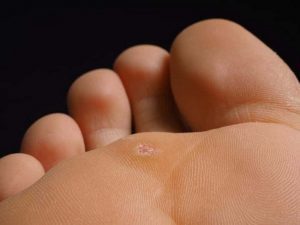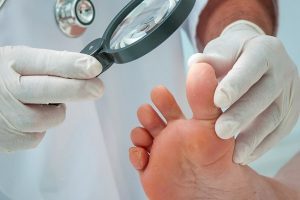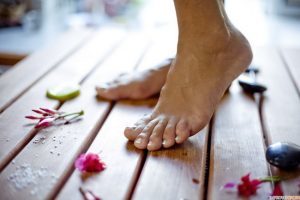Planta warts are viral growths on the skin, also called corns. As medical terminology shows, such structures are localized in the soles of the feet. In terms of cancer risk, they are not dangerous, but they cause a lot of discomfort when walking due to their heart rate.
Causes of plantation warts
All types of warts, including plantar warts, are caused by the human papillomavirus (HPV). You can get it through close contact with infected people or through daily life. The virus dies quickly in sunlight, but thrives in high humidity. Therefore, HIV infection is most common in baths, saunas and swimming pools. The virus enters the body due to microtrauma and cracks in the skin, as well as a decrease in immunity.

Once infected, a virus with strong protective properties stays in the body indefinitely. However, when the immune system is weakened, the skin begins to increase its activity, which leads to the formation of warts of various localizations. They are usually caused by subtypes 1, 2, 4, 27 and 57 of HPV.
Several factors contribute to the formation of such structures:
- shoes that are too narrow or bulky;
- high heels;
- various deformities of the foot (including flat feet);
- various diseases of the joints of the feet (arthritis, osteoarthritis, etc. ).
People with dry skin and hyperkeratosis are more likely to have warts on their feet.
Thus, the causes of plantar warts are the same in all cases (HPV infection), but the preventive factors are different. The number and size of skin elements depend on them and immunity.
How plantation warts form
Warts on the feet are like eggs on the skin. It can vary in size, but rarely exceeds two centimeters in diameter. It extends more than three millimeters above the level of the skin, but at the same time goes deeper into the veins. The color may not be different from the surrounding skin or may be dark or light. Most of these structures are yellow or gray. In appearance, you can see black dots or lines inside the elements (they are clearly visible in the picture). Blood clots are similar to capillaries due to the compression of the horny vessels by the masses.
Initially, the plantation bone has a smooth surface. But over time, it becomes harsh, rough, and thick. This gives the warts an orange color.
An important symptom of planar warts is pain when compressed. Each step grips the patient.
These warts look like plants. The resemblance to Cornish is especially noticeable in both forms of severe pain. The main difference is that the wart has no shape on the surface, but remains in the callus.
Planta Wart DiagnosisA competent dermatologist diagnoses this disease only on the basis of the clinical picture. In some cases, additional dermatoscopy is required. The absence of skin structure and the presence of blood clots in it confirm this diagnosis.
Cleaning plantar warts
Plantain warts are more difficult to get rid of because they penetrate deeper into the dermis than similar structures in other areas. External necrotic drugs can be used on small and newly formed elements. Large and deep warts are surgically removed. At the same time, old structures must first be softened with keratolytic agents.
External preparations for wart removal
In some cases, such devices may self-destruct. However, due to severe plantar disease, patients are reluctant to wait and try to get rid of them as soon as possible.
Treatment of plantar warts with necrotizing effect is prescribed for the removal of small and superficial elements.
These products contain acids that coagulate skin proteins and cause necrosis. Refrigerated medications have a similar effect. However, they do not cause chemical damage, but freeze the tissue and produce necrotizing effects.
All of these drugs are used in the direction of the device. Care must be taken to ensure that this substance does not get into the surrounding tissues, as this will cause them to burn. After treatment, the wound remains on the site of the previous wart, which is covered with a crust. When he recovers, he falls down on his own. You can do this treatment at home, but only according to your doctor's instructions.
In this way, small and shallow bones can be removed only from the skin. For large elements, you need to choose other methods of removal, because the complete destruction of the milk tissue will inevitably lead to its recurrence.
Surgical methods of removal of plantar warts

There are various ways to remove plantar warts during surgery. Soft methods are preferred:
- laser removal;
- radio wave knife;
- cryodestruction;
- electric carter.
All of these procedures are performed on an outpatient basis. Minutes after patients go straight home, the wound should be cleaned regularly at home.
The most effective and safest way to remove planar warts is to cut with a laser or radio wave knife. When they are performed, the blood vessels clot quickly, which prevents bleeding and secondary infection. Complications in removing the structure of the skin using these methods are rare. The same cannot be said of cryodestruction and electrocoagulation, so these treatments are rarely used in the background.
If the warts are large or old (covered with a large number of horny masses), it is recommended to treat them with keratolytic agents for two weeks before the procedure. For this purpose, drugs other than salicylic oil or acid are prescribed. Thus, part of the horn scales can be oxidized to make the structure softer and more flexible. This removes warts easily and quickly.
In rare cases, when there are many elements or when there is doubt about their nature, the doctor recommends a surgical incision with a scalpel. This method of wart removal is used only with strict instructions, as it has a high recovery period and the risk of scarring.
Features of plantation warts in children
Plantation warts are more common in children over the age of five because they run barefoot, get injured, and do not always follow the rules of personal hygiene. Immune deficiency due to regular contact with sick children (kindergartens and schools) increases the risk of warts.
Treatment of such devices in a child is best started with external agents. You can try to oxidize the shallow elements with the help of salicylic oil, and then pumice. Immunomodulatory drugs have proven themselves. If you use it regularly, you can remove it after a few weeks.
If the elements are deep, use necrotic agents or remove with a laser or radio wave knife.
Prevention of plantar warts

It is impossible to protect yourself from warts, but you can reduce the risk of them. To do this, you need to work in two directions: to eliminate predisposing factors and to stimulate the body's defenses.
To achieve the first goal, you need:
- follow the rules of personal hygiene (do not walk barefoot in public places, wash your feet every day and treat cut wounds in a timely manner);
Choose comfortable shoes by size- ;
- Over time, it is important to prevent foot deformities and treat joint pain.
Healthy living, exercise, exercise, vitamin complexes, and immunostimulants, as prescribed by your doctor, can help keep your body healthy.
In case of excessive dry skin and hyperkeratosis, medical pedicure and peeling is recommended. Excessive sweating of the feet should be treated with special means for the treatment of hyperhidrosis. By following all these rules, there is less risk of warts on the soles of the feet.
Plantar warts are not a dangerous disease, but they can cause a lot of inconvenience due to pain when walking. Fortunately, modern medicine has many ways to deal with the risk of recurrence. To do this, you should consult a dermatologist and strictly follow all his appointments and recommendations.
A competent dermatologist diagnoses this disease only on the basis of the clinical picture. In some cases, additional dermatoscopy is required. The absence of skin structure and the presence of blood clots in it confirm this diagnosis.
Cleaning plantar warts
Plantain warts are more difficult to get rid of because they penetrate deeper into the dermis than similar structures in other areas. External necrotic drugs can be used on small and newly formed elements. Large and deep warts are surgically removed. At the same time, old structures must first be softened with keratolytic agents.
External preparations for wart removal
In some cases, such devices may self-destruct. However, due to severe plantar disease, patients are reluctant to wait and try to get rid of them as soon as possible.
Treatment of plantar warts with necrotizing effect is prescribed for the removal of small and superficial elements.
These products contain acids that coagulate skin proteins and cause necrosis. Refrigerated medications have a similar effect. However, they do not cause chemical damage, but freeze the tissue and produce necrotizing effects.
All of these drugs are used in the direction of the device. Care must be taken to ensure that this substance does not get into the surrounding tissues, as this will cause them to burn. After treatment, the wound remains on the site of the previous wart, which is covered with a crust. When he recovers, he falls down on his own. You can do this treatment at home, but only according to your doctor's instructions.
In this way, small and shallow bones can be removed only from the skin. For large elements, you need to choose other methods of removal, because the complete destruction of the milk tissue will inevitably lead to its recurrence.
Surgical methods of removal of plantar warts

There are various ways to remove plantar warts during surgery. Soft methods are preferred:
- laser removal;
- radio wave knife;
- cryodestruction;
- electric carter.
All of these procedures are performed on an outpatient basis. Minutes after patients go straight home, the wound should be cleaned regularly at home.
The most effective and safest way to remove planar warts is to cut with a laser or radio wave knife. When they are performed, the blood vessels clot quickly, which prevents bleeding and secondary infection. Complications in removing the structure of the skin using these methods are rare. The same cannot be said of cryodestruction and electrocoagulation, so these treatments are rarely used in the background.
If the warts are large or old (covered with a large number of horny masses), it is recommended to treat them with keratolytic agents for two weeks before the procedure. For this purpose, drugs other than salicylic oil or acid are prescribed. Thus, part of the horn scales can be oxidized to make the structure softer and more flexible. This removes warts easily and quickly.
In rare cases, when there are many elements or when there is doubt about their nature, the doctor recommends a surgical incision with a scalpel. This method of wart removal is used only with strict instructions, as it has a high recovery period and the risk of scarring.
Features of plantation warts in children
Plantation warts are more common in children over the age of five because they run barefoot, get injured, and do not always follow the rules of personal hygiene. Immune deficiency due to regular contact with sick children (kindergartens and schools) increases the risk of warts.
Treatment of such devices in a child is best started with external agents. You can try to oxidize the shallow elements with the help of salicylic oil, and then pumice. Immunomodulatory drugs have proven themselves. If you use it regularly, you can remove it after a few weeks.
If the elements are deep, use necrotic agents or remove with a laser or radio wave knife.
Prevention of plantar warts

It is impossible to protect yourself from warts, but you can reduce the risk of them. To do this, you need to work in two directions: to eliminate predisposing factors and to stimulate the body's defenses.
To achieve the first goal, you need:
- follow the rules of personal hygiene (do not walk barefoot in public places, wash your feet every day and treat cut wounds in a timely manner);
Choose comfortable shoes by size- ;
- Over time, it is important to prevent foot deformities and treat joint pain.
Healthy living, exercise, exercise, vitamin complexes, and immunostimulants, as prescribed by your doctor, can help keep your body healthy.
In case of excessive dry skin and hyperkeratosis, medical pedicure and peeling is recommended. Excessive sweating of the feet should be treated with special means for the treatment of hyperhidrosis. By following all these rules, there is less risk of warts on the soles of the feet.
Plantar warts are not a dangerous disease, but they can cause a lot of inconvenience due to pain when walking. Fortunately, modern medicine has many ways to deal with the risk of recurrence. To do this, you should consult a dermatologist and strictly follow all his appointments and recommendations.

Plantain warts are more difficult to get rid of because they penetrate deeper into the dermis than similar structures in other areas. External necrotic drugs can be used on small and newly formed elements. Large and deep warts are surgically removed. At the same time, old structures must first be softened with keratolytic agents.
External preparations for wart removal
In some cases, such devices may self-destruct. However, due to severe plantar disease, patients are reluctant to wait and try to get rid of them as soon as possible.
Treatment of plantar warts with necrotizing effect is prescribed for the removal of small and superficial elements.
These products contain acids that coagulate skin proteins and cause necrosis. Refrigerated medications have a similar effect. However, they do not cause chemical damage, but freeze the tissue and produce necrotizing effects.
All of these drugs are used in the direction of the device. Care must be taken to ensure that this substance does not get into the surrounding tissues, as this will cause them to burn. After treatment, the wound remains on the site of the previous wart, which is covered with a crust. When he recovers, he falls down on his own. You can do this treatment at home, but only according to your doctor's instructions.
In this way, small and shallow bones can be removed only from the skin. For large elements, you need to choose other methods of removal, because the complete destruction of the milk tissue will inevitably lead to its recurrence.
Surgical methods of removal of plantar warts

There are various ways to remove plantar warts during surgery. Soft methods are preferred:
- laser removal;
- radio wave knife;
- cryodestruction;
- electric carter.
All of these procedures are performed on an outpatient basis. Minutes after patients go straight home, the wound should be cleaned regularly at home.
The most effective and safest way to remove planar warts is to cut with a laser or radio wave knife. When they are performed, the blood vessels clot quickly, which prevents bleeding and secondary infection. Complications in removing the structure of the skin using these methods are rare. The same cannot be said of cryodestruction and electrocoagulation, so these treatments are rarely used in the background.
If the warts are large or old (covered with a large number of horny masses), it is recommended to treat them with keratolytic agents for two weeks before the procedure. For this purpose, drugs other than salicylic oil or acid are prescribed. Thus, part of the horn scales can be oxidized to make the structure softer and more flexible. This removes warts easily and quickly.
In rare cases, when there are many elements or when there is doubt about their nature, the doctor recommends a surgical incision with a scalpel. This method of wart removal is used only with strict instructions, as it has a high recovery period and the risk of scarring.
Features of plantation warts in children
Plantation warts are more common in children over the age of five because they run barefoot, get injured, and do not always follow the rules of personal hygiene. Immune deficiency due to regular contact with sick children (kindergartens and schools) increases the risk of warts.
Treatment of such devices in a child is best started with external agents. You can try to oxidize the shallow elements with the help of salicylic oil, and then pumice. Immunomodulatory drugs have proven themselves. If you use it regularly, you can remove it after a few weeks.
If the elements are deep, use necrotic agents or remove with a laser or radio wave knife.
Prevention of plantar warts

It is impossible to protect yourself from warts, but you can reduce the risk of them. To do this, you need to work in two directions: to eliminate predisposing factors and to stimulate the body's defenses.
To achieve the first goal, you need:
- follow the rules of personal hygiene (do not walk barefoot in public places, wash your feet every day and treat cut wounds in a timely manner); Choose comfortable shoes by size
- ;
- Over time, it is important to prevent foot deformities and treat joint pain.
Healthy living, exercise, exercise, vitamin complexes, and immunostimulants, as prescribed by your doctor, can help keep your body healthy.
In case of excessive dry skin and hyperkeratosis, medical pedicure and peeling is recommended. Excessive sweating of the feet should be treated with special means for the treatment of hyperhidrosis. By following all these rules, there is less risk of warts on the soles of the feet.
Plantar warts are not a dangerous disease, but they can cause a lot of inconvenience due to pain when walking. Fortunately, modern medicine has many ways to deal with the risk of recurrence. To do this, you should consult a dermatologist and strictly follow all his appointments and recommendations.














































































